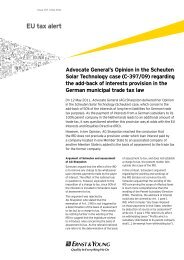Download - Ernst & Young T Magazine
Download - Ernst & Young T Magazine
Download - Ernst & Young T Magazine
Create successful ePaper yourself
Turn your PDF publications into a flip-book with our unique Google optimized e-Paper software.
Management Leading virtual teams<br />
Summary<br />
The rise of<br />
globalization and<br />
technology has seen an<br />
increase in the use of<br />
virtual teams. Despite<br />
this, relatively little<br />
is yet known about the<br />
best practices of<br />
how to manage such<br />
teams, from the tools<br />
required to alternative<br />
management practices.<br />
97%<br />
Percentage of Accenture<br />
employees in an internal poll<br />
who agreed that new<br />
videoconferencing technology<br />
was a good substitute for<br />
face-to-face meetings.<br />
$2.2b<br />
The estimated size of the<br />
telepresence videoconferencing<br />
market at end 2010, which is<br />
expected to more than double<br />
to US$4.7 billion by 2014.<br />
• By Kim Thomas<br />
The days when a team consisted of a group<br />
of people who arrived at the same office at<br />
9:00 a.m. each day are long gone.<br />
Knowledge workers now often work from home,<br />
and may live in different parts of the country or<br />
even across several countries and time zones.<br />
This change has been driven by a combination<br />
of factors: a recognition that staff may need to<br />
balance work with family commitments; an<br />
awareness that the ability to work offsite is a<br />
useful option during epidemics, riots or bad<br />
weather; a desire to save on travel and office<br />
costs, especially during difficult economic<br />
conditions; increasingly capable and cost-effective<br />
technology that can help make collaboration far<br />
easier and more effective; and ongoing<br />
globalization, which makes cross-border global<br />
teams a now common and essential part of doing<br />
business. In her recent book, The Shift, London<br />
Business School Professor Lynda Gratton argues<br />
that virtual working will largely become the norm<br />
for most office workers in the coming decade.<br />
There are some clear benefits to this approach,<br />
not least of which is the opportunity to bring<br />
together different experiences and perspectives.<br />
But it also brings obvious challenges for<br />
managers: in a team of people who rarely see<br />
each other, individual members can feel isolated,<br />
and may lack the opportunity to share ideas or<br />
engage in casual conversation that can spark a<br />
fruitful idea. While research shows that people<br />
who work from home tend to be more productive<br />
than those working in an office, the opposite is<br />
the case for virtual teams, according to a recent<br />
study from The Society for Human Resource<br />
Management. As Richard Edwards, Principal<br />
Analyst at Ovum, points out, even in co-located<br />
teams, managers need to accommodate the fact<br />
that people have different styles of working. “It<br />
can exacerbate and challenge team-working more<br />
if you are separated,” he says.<br />
Rethinking virtual management<br />
So what is the secret to managing a virtual team<br />
successfully? INSEAD Professor José Santos has<br />
found that teams where each member has a<br />
clearly defined role and focus work better than<br />
ones where roles are loosely defined. The<br />
measurement of performance also needs to<br />
adapt – toward a system where team members<br />
are measured on outputs. “You have to focus on<br />
performance rather than on how people are<br />
behaving with you,” says Bill Shedden, Director<br />
of the Centre for Customised Executive<br />
Development at Cranfield School of Management.<br />
Other things can help. Although it’s not always<br />
feasible, teams that have had a chance to meet<br />
before they start working virtually tend to be<br />
more effective. Without this, team meetings can<br />
be challenging, especially for a team that spans<br />
multiple cultures. Some may wish to speak but<br />
find it difficult to interrupt a conversation in<br />
mid-flow and so will opt to stay silent.<br />
Until recently, videoconferencing has<br />
remained an imperfect alternative, often with<br />
out-of-sync audio and video, or an inability to see<br />
participants clearly. This is quickly changing.<br />
Sales of telepresence videoconference<br />
technology, which uses multiple screens and<br />
high-quality audio to simulate people sitting at<br />
the same table, have increased rapidly. In 2010,<br />
the market grew 18%, totaling US$2.2 billion, and<br />
analyst firm Frost & Sullivan expects it to more<br />
than double to US$4.7 billion by 2014. Already,<br />
as costs reduce, such systems are becoming<br />
more widespread. Accenture is just one example<br />
of a multinational that is rolling out a significant<br />
number of telepresence systems globally; it<br />
already had over 50 in place by early 2010. In an<br />
internal poll, 97% of Accenture employees said<br />
that the technology was a good substitute for<br />
face-to-face meetings. “To see people’s faces<br />
makes the discussion just more productive,” says<br />
Thomas Efkemann, an Executive Director for<br />
Assignment Services at <strong>Ernst</strong> & <strong>Young</strong>. “You see,<br />
for example, when someone doesn’t agree with<br />
your comments – how someone is shaking their<br />
head or trying to get into a call.”<br />
Technology isn’t the only answer<br />
But technology alone is not the answer;<br />
management practices have to adapt too. “One<br />
consideration is to reduce the number of<br />
meetings,” says Efkemann, “but to make sure<br />
that those you do hold have very clearly defined<br />
aims.” Shedden agrees, not least due to often<br />
challenging time zone considerations. “You’ve<br />
got to pay a lot of attention to the managing of<br />
the team in terms of who’s going to be there,<br />
what’s the purpose of the meeting, what are the<br />
outcomes we expect, because for some people it<br />
will be at an unsocial time. You also want to<br />
ensure that you stick to time, because a person<br />
might be waiting to go home – he might be<br />
waiting till eight o’clock at night because he’s in a<br />
different time zone to you.” To grapple with this,<br />
some teams opt to rotate the times of meetings.<br />
Managers also need to ensure that everyone<br />
has a chance to speak, particularly when there<br />
isn’t a common first language. With meetings<br />
typically defaulting to English, some team<br />
members may need more thinking time, rather<br />
than being rushed into a response. One way of<br />
helping this along is to give team members in<br />
different locations a turn at chairing meetings, so<br />
it’s not always the same manager who chairs.<br />
Another common solution is to record a<br />
teleconference and make it available later for<br />
those who were unable to take part, allowing<br />
them to add written comments.<br />
A further consideration relates to cultural<br />
differences. Team members in different countries<br />
will be used to different meeting styles. In an<br />
38 T <strong>Magazine</strong> Issue 07 <strong>Ernst</strong> & <strong>Young</strong>

















